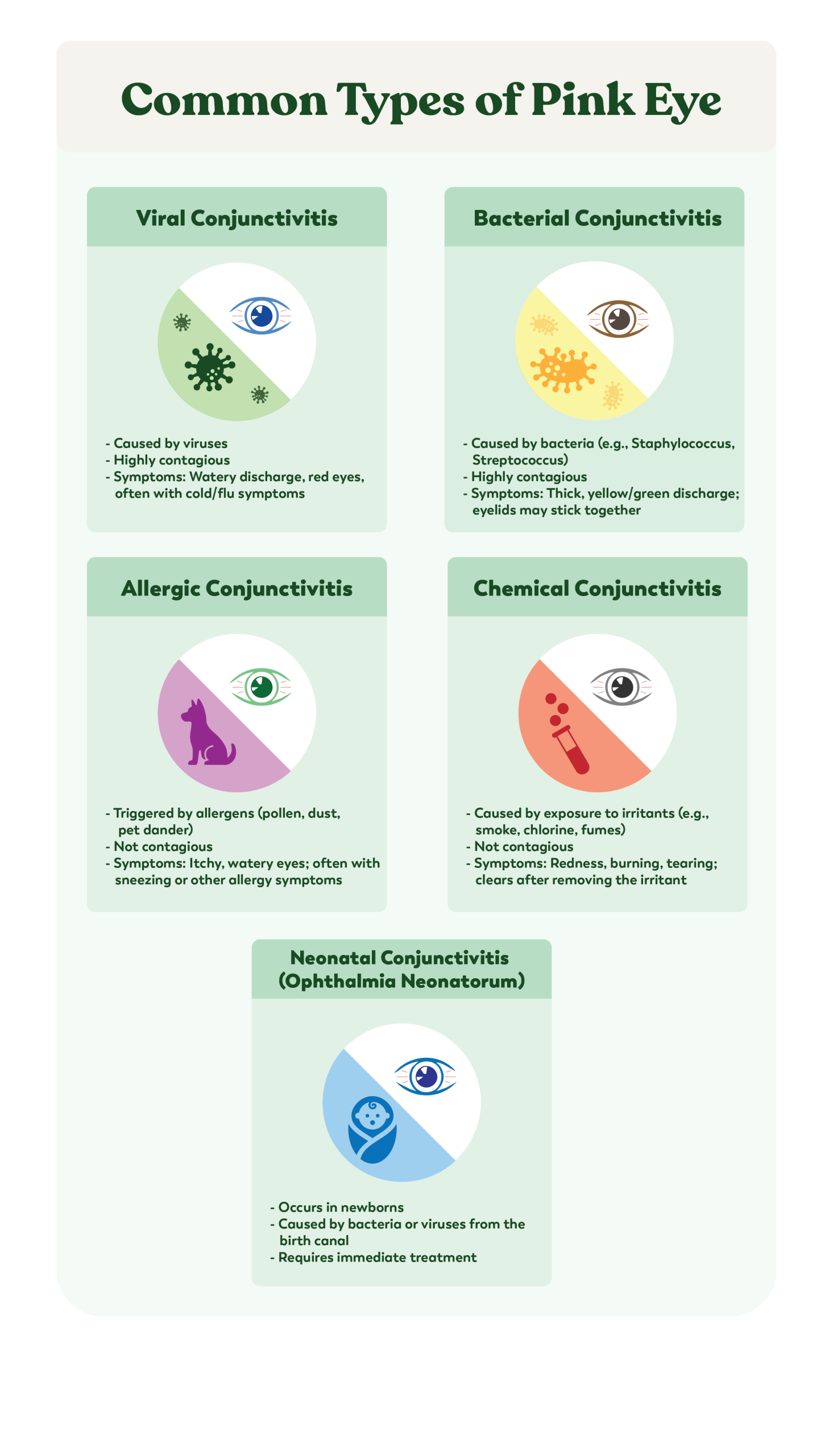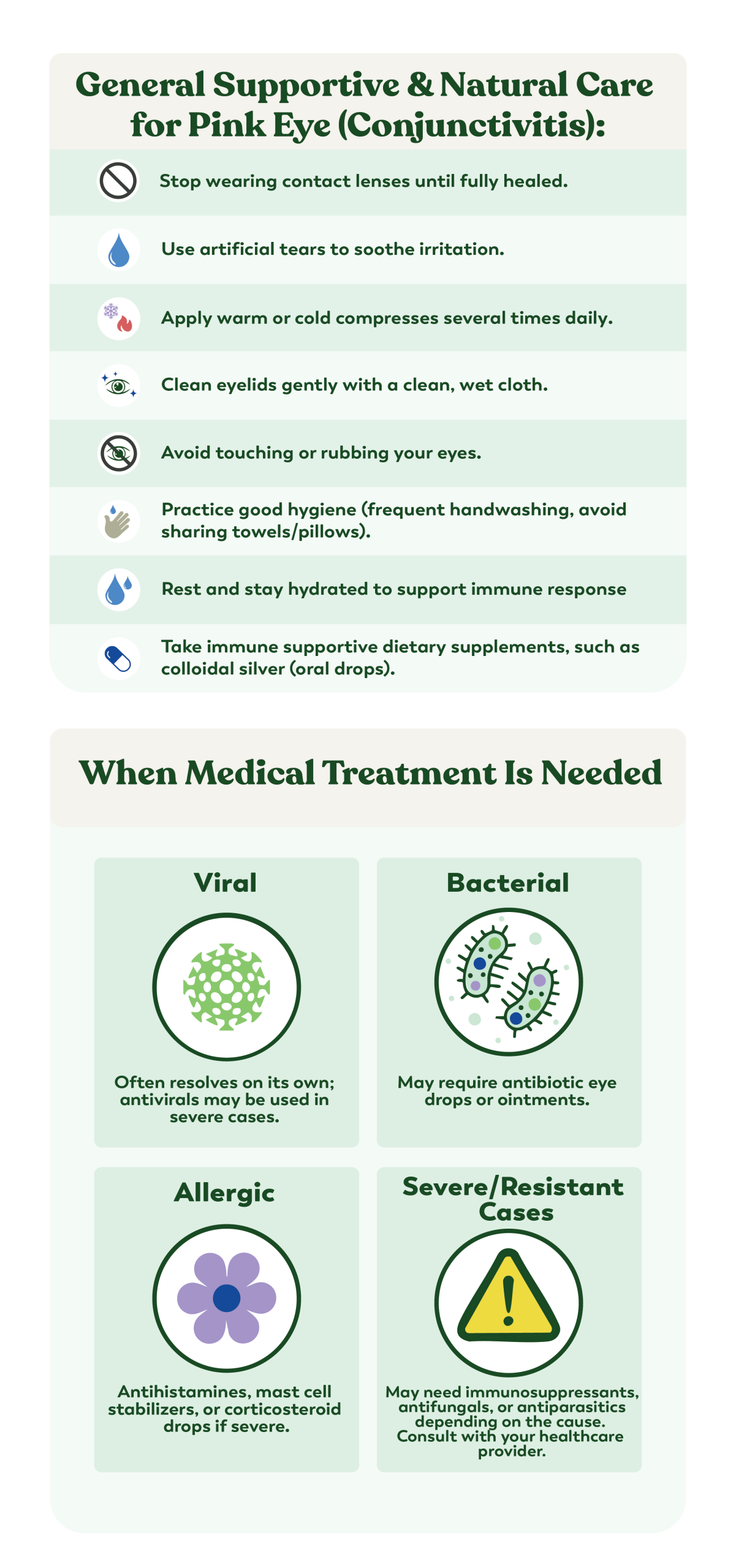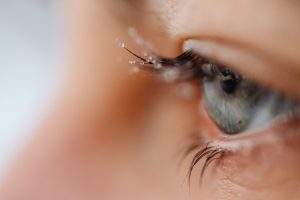Pink eye can be itchy, irritating, and downright frustrating. How do you get pink eye? How long does pink eye last? Is pink eye contagious? If so, how long is pink eye contagious? Or, more importantly, you may be wondering how to get rid of pink eye.
Many people experiencing pink eye are asking questions like these, exploring natural approaches alongside conventional treatments. One option that has gained attention is colloidal silver. But what is colloidal silver, and does it actually work?
This guide examines pink eye, the role of colloidal silver in immune support as it relates to this condition, why you should take colloidal silver for immune support, alternatives for relief, and evidence-based approaches to managing pink eye naturally and effectively.
What is Pink Eye (Conjunctivitis)?
Pink eye, or conjunctivitis, is an inflammation of the conjunctiva, the clear membrane covering the white part of the eye. It often presents in viral, bacterial, or allergic forms. Symptoms include redness, watery eyes, itching, a burning sensation, and sometimes discharge. Pink eye is highly contagious, and early diagnosis and treatment are essential to prevent its spread.
Types of Pink Eye
Understanding the different types of pink eye can help clarify your questions and inform your action plan. What is the best treatment option? How long does pink eye last? How long is it contagious?
- Viral Pink Eye: Viral conjunctivitis is the most common type of pink eye. Is viral pink eye contagious? Absolutely—it is highly contagious while symptoms are present. It can spread easily through respiratory droplets, contaminated surfaces, and direct contact. Viral pink eye typically resolves on its own within 7-10 days; however, it can last up to 3 weeks.
- Bacterial Pink Eye: What about bacterial pink eye? Bacterial pink eye is an eye infection that often produces thick, yellow-green discharge and requires antibiotic treatment. Without treatment, bacterial conjunctivitis can lead to serious complications. It can last 24-48 hours after starting antibiotics; untreated, it can last 1-2 weeks. Bacterial pink eye is highly contagious, but usually not contagious 24 hours after starting antibiotic treatment.
- Allergic Pink Eye: Allergic conjunctivitis results from exposure to allergens like pollen, dust mites, or pet dander. It is not contagious. How long does allergic conjunctivitis last? It typically persists as long as you’re exposed to the triggering allergen.
How Do You Get Pink Eye?
Understanding how you get pink eye helps with prevention. Common causes include:
- Viral infections from common cold or flu viruses.
- Bacterial infections from touching contaminated surfaces.
- Allergen exposure to pollen, dust, or pet dander.
- Chemical irritants from smoke, chlorine, or cosmetics.
- Contact lens complications from improper cleaning or extended wear.
- Poor hygiene, including sharing eye makeup or towels.

Common Symptoms of Pink Eye
Pink eye symptoms can vary depending on the underlying cause:
- Redness in the White of the Eye: This symptom results from dilated blood vessels responding to irritation, infection, or allergic reactions. The redness can range from light pink to deep red.
- Watery or Teary Eyes: Excessive tearing occurs as your eyes attempt to flush out irritants or pathogens. This can cause continuous watery eyes and may be accompanied by blurred vision and sensitivity to light.
- Itchiness or Irritation: Eye itching is common with allergic conjunctivitis. Rubbing the eyes should be avoided to prevent further irritation or infection spread.
- Burning Sensation: Many people experience a burning feeling, as if something gritty is in the eye.
- Discharge or Crusting: Discharge varies by type—clear with viral infections, thick and colored with bacterial infections. Crusting often occurs overnight when discharge dries, causing eyelids to stick together.
Considering Colloidal Silver
What Is Colloidal Silver?
Given the popularity of colloidal silver as an alternative remedy for conjunctivitis, it’s important to understand what it actually is. Colloidal silver consists of tiny silver particles suspended in liquid. Historically used in traditional medicine, it has gained attention for its purported antimicrobial properties.
Traditionally, colloidal silver has been used as oral drops for general immune support rather than direct eye application. Many people incorporate it into their wellness routines seasonally when their immune system needs additional support.
What Are the Risks and Side Effects?
It is crucial to acknowledge the risks and side effects associated with the use of colloidal silver. The U.S. Food and Drug Administration (FDA) has expressed concerns over the use of colloidal silver. Both oral and direct eye application can lead to serious, permanent side effects, including irreversible blue-gray discoloration of the eye tissue called ocular argyrosis. Other risks include interference with medications and possible organ damage from prolonged use.
There is currently no clinical evidence supporting the effectiveness of colloidal silver for treating eye conditions, and its direct eye use is considered unsafe by medical professionals. Consult a health professional to mitigate these risks.
Supporting Your Immune System During Recovery
Recommended Products
While direct eye application of colloidal silver is not recommended, many people find value in using high-quality colloidal silver products as oral supplements to support their immune system during recovery from conjunctivitis. Note that many cases of viral pink eye resolve naturally as the immune system fights the infection, yet supplemental support may be beneficial.*
- Argentyn 23 Professional Bio-Active Silver: This professional-grade bioactive silver solution provides immune support through oral supplementation. Argentyn 23 is formulated with advanced technology for optimal bioavailability.
- Sovereign Silver Bio-Active Silver: A trusted brand offering bio-active silver for immune system support. Available in various formulations, including adult and children’s versions.
- Sovereign Silver Bio-Active Silver for Kids – Fine Mist Spray: Specially formulated for children’s immune support needs, Sovereign Silver Bio-Active Silver for Kids is available in both fine mist spray and dropper formulations for easy administration to support children’s immune support needs.
- Zahler Colloidal Silver: Zahler Colloidal Silver provides traditional colloidal silver support for overall wellness and immune system maintenance.

How to Get Rid of Pink Eye: Safe, Evidence-Based Approaches
Instead of direct eye application of colloidal silver, consider these clinically supported approaches for pink eye relief:
Immediate Care Steps
- Stop wearing contact lenses. Remove contact lenses immediately and switch to glasses until symptoms resolve completely. Contact lenses can trap bacteria and prolong infection.
- Use artificial tears. Over-the-counter artificial tears help flush irritants and provide moisture. Choose preservative-free options for frequent use.
- Clean your eyelids gently. Use a clean, damp washcloth with warm water to gently remove discharge and crusting. Use a fresh section of the cloth for each eye to prevent cross-contamination.
- Apply warm or cold compresses. A warm compress can soothe bacterial conjunctivitis, while cold compresses often provide relief for allergic reactions. Apply several times daily for 5-10 minutes.
How to Get Rid of Pink Eye Fast
Learning how to get rid of pink eye fast starts with identifying whether you’re dealing with a bacterial, viral, or allergic form of conjunctivitis. The fastest resolution of pink eye comes from:
- Proper diagnosis to determine the specific type.
- Appropriate treatment based on the cause.
- Good hygiene practices to prevent reinfection.
- Avoiding irritants like eye makeup and contact lenses.
- Following medical advice completely.
Additional Immune-Supporting Approaches
Professional Treatment
While many cases of pink eye can be managed at home, certain symptoms indicate the need for immediate medical attention. Contact a healthcare provider if you experience:
- Severe eye pain that interferes with daily activities.
- Significant vision changes, such as blurriness or difficulty focusing.
- Light sensitivity, making it uncomfortable to be in normal lighting conditions.
If your symptoms worsen after 2-3 days of home care, this may indicate a more serious infection requiring prescription treatment. Signs of systemic infection requiring prompt medical attention include:
- Fever.
- Severe swelling around the eye area.
- Recurrent episodes of conjunctivitis, suggesting a possible underlying condition needing specialized care.
Healthcare providers may prescribe various treatments depending on the type of pink eye:
- Antibiotic eye drops or ointments for bacterial infections.
- Antiviral medications for severe viral cases.
- Antihistamine drops for allergic conjunctivitis.
- Corticosteroid drops for severe inflammation.
- Immunosuppressants for chronic allergic cases.
Recognizing pink eye vs allergies helps determine whether you need antibiotic treatment or allergy management strategies.
Homeopathy
What is homeopathy? Homeopathy is a holistic system of medicine based on the principle that the body can heal itself using highly diluted natural substances to stimulate the immune system. This approach supports the body’s natural healing processes by encouraging its own defensive mechanisms. Some practitioners recommend homeopathic remedies in conjunction with conventional treatments for pink eye to support overall recovery.
Natural Support
While avoiding the direct eye application of unproven remedies, you can support your body’s natural healing process through what some might call “home remedies”:
- Green tea compresses: Cool green tea bags can provide anti-inflammatory benefits when applied to closed eyelids. The natural antioxidants may help reduce inflammation.
- Good hygiene: Wash your hands frequently with antibacterial soap and warm water, and avoid sharing towels, washcloths, or eye makeup. While infected, change pillowcases daily and clean eyeglasses thoroughly.
- Lifestyle adjustments: Stay hydrated, manage your stress levels, and get adequate sleep.
- Diet and supplements: Eat foods rich in the following:
- Vitamin A for eye health.
- Vitamin C for immune function.
- Zinc for wound healing and immune support.
- Omega-3 fatty acids for anti-inflammatory effects.
Natural Healthy Concepts sells a wide variety of vitamins and minerals, including all those listed above and more, which have been vetted for quality and efficacy by our certified healthcare practitioners.
Can You Go to School with Pink Eye?
Most schools require students to stay home with infectious pink eye. The answer to the question, “Can you go to school with pink eye,” depends on:
- Type of conjunctivitis (infectious vs. allergic)
- School policies
- Whether treatment has started
- Symptom severity
Generally, children should stay home until symptoms improve and they’ve been on treatment for 24 hours if bacterial. So, if you’re wondering “Can you go to school with pink eye,” the safe bet is to allow your infected child to stay home and rest for at least one day until they receive medical treatment for pink eye.
What is Commonly Misdiagnosed as Pink Eye?
Pink Eye vs Allergies: Key Differences
Distinguishing between infectious pink eye and allergic reactions is crucial for proper treatment:
- Infectious Pink Eye: Infectious pink eye usually affects one eye initially, and then it may spread to the other eye. Cold-like symptoms and discharge are common.
- Allergic Conjunctivitis: Allergic conjunctivitis typically affects both eyes simultaneously. It is associated with other allergy symptoms (e.g., sneezing, runny nose). Intense itching is prominent, and there may be a clear, watery discharge.
The pink eye vs allergies question gets easier to answer when you consider the full picture—allergic eye irritation rarely happens alone and usually comes with sneezing and nasal congestion.
Similar Eye Conditions
When considering what is commonly misdiagnosed as pink eye, note that several conditions share symptoms with conjunctivitis, often leading to confusion:
- Dry eyes can cause redness and irritation.
- Styes or chalazions may cause localized swelling.
- Corneal abrasions can produce tearing and discomfort.
- Uveitis causes redness and light sensitivity.
- Glaucoma may present with redness and eye pain.
The Bottom Line on Natural Pink Eye Support
While exploring natural approaches to health challenges is understandable, safety must always be the top priority. Direct application of colloidal silver to the eyes carries significant risks without proven benefits. However, high-quality colloidal silver products taken orally may provide immune system support during recovery from infections like conjunctivitis.
The most effective approach combines proper medical care with evidence-based natural support methods. Many cases of viral pink eye resolve naturally as your immune system addresses the infection. Supporting this process through proper nutrition, rest, hygiene, artificial tears, and appropriate oral supplements can help optimize healing while avoiding complications.
How to get rid of pink eye effectively depends on identifying the type you’re dealing with. Bacterial infections require antibiotic treatment, while viral cases benefit from supportive care and immune system support. Remember that persistent or severe symptoms require a professional medical evaluation for the safest and most effective treatment approach.
Frequently Asked Questions
How long is pink eye contagious after starting drops?
For bacterial pink eye, you’re typically no longer contagious 24 hours after starting antibiotic treatment. However, if you’re wondering “is viral pink eye contagious,” it remains infectious as long as symptoms are present, typically 7-10 days. Consult your healthcare provider about when it’s safe to return to work or school.
What is a condition commonly misdiagnosed as pink eye?
Several conditions can mimic pink eye symptoms, including dry eyes, styes, corneal abrasions, allergic reactions to eye makeup, and even more serious conditions like uveitis or glaucoma. This is why professional diagnosis is essential, especially if symptoms are severe or don’t improve with basic care.
Can you go to school with pink eye?
Generally, children should stay home from school when they have infectious pink eye. Most schools require students to be symptom-free or have been on antibiotic treatment for 24 hours (for bacterial cases) before returning. Allergic conjunctivitis is not contagious, so school attendance may be possible if the child feels well enough.
Is colloidal silver safe to use directly in the eyes?
No, the FDA does not recommend using colloidal silver directly in the eyes. This can cause permanent blue-gray discoloration of eye tissue and other serious side effects. Instead, colloidal silver is traditionally used as oral drops for immune support.
How long does pink eye last without treatment?
Viral pink eye typically lasts 7-10 days without treatment, though it can persist up to 3 weeks. Bacterial pink eye may last 1-2 weeks without antibiotics, but resolves much faster with proper treatment. How long does allergic conjunctivitis last? Allergic conjunctivitis continues as long as you’re exposed to the triggering allergen.
What’s the difference between pink eye and allergies affecting the eyes?
Allergic conjunctivitis usually affects both eyes simultaneously and is accompanied by other allergy symptoms like sneezing or a runny nose. The itching is typically more intense than with infectious pink eye. Infectious pink eye often starts in one eye, may spread to the other, and frequently occurs with cold symptoms.
How can I get rid of pink eye fast naturally?
If you’re wondering how to get rid of pink eye fast, in some cases, an all-natural approach may be all that’s necessary. While supporting natural healing, focus on maintaining proper hygiene, using warm or cool compresses, artificial tears, and avoiding irritants such as contact lenses and eye makeup. However, bacterial pink eye requires antibiotic treatment for the fastest resolution. Always consult a healthcare provider for proper diagnosis and treatment recommendations.
*FDA disclaimer: these product descriptions have not been evaluated by the Food and Drug Administration, and these products are not intended to diagnose, treat, cure, or prevent any disease.
* These statements have not been evaluated by the Food and Drug Administration. The products mentioned are not intended to diagnose, treat, cure, or prevent any disease.






